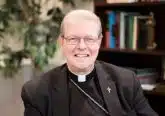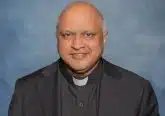Some U.S. seminaries report surge in enrollments even as nationwide numbers remain flat
Washington, D.C. Newsroom, Aug 12, 2023 / 08:00 am
Seminarian enrollment in the United States has been on a decadeslong decline as fewer young men seek out the priesthood and the number of active priests in the U.S. continues to dwindle. But some dioceses are reporting a notable surge in enrollment, signaling a potential turnaround in some regions.
Annual data from the Center for Applied Research in the Apostolate at Georgetown University, released in June of this year, showed “a continuation of relatively slow long-term decline” in priestly vocations at the pre-theology and theology levels, falling from over 6,400 men in 1970 to 2,759 in the most recent academic year.
Similar sharp drops have been observed in both college- and high school-level seminarian enrollment over the same time period. In recent years the decline in priests and seminarians has been observed globally as well.
Yet some seminary and diocesan officials told CNA that the number of seminarians they have in training for the priesthood has increased in recent years.
Father Joe Taphorn, the rector of Saint Paul Seminary School of Divinity in Minneapolis, said the school’s current class of seminarians is the largest of his nearly five-year tenure there.
“That first fall we had 77 seminarians,” Taphorn told CNA. “We’ll probably be at just over 100 this fall. And that’s basically almost full. We’re kind of nearing capacity.”
The school’s growth has been ongoing. In 2021, the seminary experienced its largest one-year increase in enrollment since 1975, going from 70 seminarians to 90 seminarians. In the spring of this year, 16 seminarians from the school were ordained transitional deacons.
“We’re never going to be the largest seminary, just because of our facilities,” he said. “But if we do formation well, and prepare our men well, and cast a positive vision — that’s attractive to young men. There continues to be interest and vocational visits from young men who want to learn more.”
Taphorn said the Church needs to be proactive in how it encourages young men to seek out the priesthood.
“We need a mindset not of retreat but of advancing,” he said. “I think young people are looking for something that is more than the world offers. I think there’s aspirations for greatness. That’s really found ultimately in holiness and in sacrificial love.”
The decline in vocations around the U.S. has for years impelled dioceses and bishops to take sometimes-drastic measures to address priestly shortages. A major initiative to merge parishes in the Archdiocese of St. Louis, for example, is being driven in part by a looming priest shortage on the horizon as more priests retire and not enough are being ordained to replace them.
The Diocese of Columbus, Ohio, is also in the process of closing over a dozen parishes in part due to what Bishop Earl K. Fernandes called an “aging clergy.”
Nevertheless, there are encouraging signs in more than just Minnesota. One Voice, the official magazine of the Diocese of Birmingham, Alabama, reported last month that “for the first time in diocesan history, this fall, there will be 19 men in studies and formation at three different [Birmingham] seminaries.”
Father Wyman Vintson, the director of diocesan vocations there, said Birmingham has had “the same shortage of priests that everybody throughout the country has had” in recent years.
However, the surge in seminarians, he said, is “an indication of a growth in the Church” in the region.
“It helps to generate some optimism among the clergy as well as the laity,” he said. “It’s a very encouraging thing to have the most seminarians you’ve had in 54 years.”
Vintson said the diocese sends its seminarians to several regional seminaries, including Pontifical College Josephinum in Columbus, Ohio, and Notre Dame Seminary in New Orleans. He said it looks like the elevated number of seminarians enjoyed by the diocese may remain high in the near future.
“We have four in application at the moment. It’s looking very positive,” he said. “We just keep trying to focus on being open to the call that Jesus is making to these men as they approach us.”
Vintson said the vocations office does much of its outreach through campus ministry programs. He said young men who show an interest in the priesthood are often permitted to spend a weekend at one of the diocesan seminaries in order to see if they want to pursue the vocation further.
“We’re very proud of our seminarians,” he said, “and we’re thankful to the people of the diocese who are helping to send them to seminary and nurture and affirm them and help them to grow.”
Sandy Cunningham, the marketing director at Saint Joseph Abbey and Seminary College in Saint Benedict, Louisiana, said her school’s enrollment numbers are “pretty much unchanged” over recent years, with “about 100 [students] plus or minus.”
She said the school estimates that “only 25% of our students become priests” on a regular basis.
Yet Cunningham did say that in a recent batch of 30 graduates “only two reported they were not continuing on toward the priesthood.” Those graduates were “either receiving a bachelor’s degree or finishing a two-year theology program for students who already had a bachelor’s degree,” she said. (Those high numbers were “not the norm,” she pointed out.)
What’s driving local surges?
A vital question for the Church, of course, is: What’s driving localized spikes in seminarian enrollment? And can it be replicated elsewhere?
Father Carter Griffin, the rector of Saint John Paul II Seminary in Washington, D.C., said the strong numbers in some dioceses and seminaries are likely the result of years of long work on the part of local Church leaders.
“The most successful promoters of the priesthood are joyful, faithful priests in the parishes,” he told CNA.
“Consistently strong numbers [not just a banner year] are the cumulative effect of many years of careful selection and formation of priests,” he said. “One has to play the long game, not just get big numbers in the seminary, so that there are healthy priests in parishes.”
“Getting vocations from zero to 60 takes 20 years, not two years,” he added. “It’s building a genuine culture of vocations, not a slick vocations program.”
Griffin suggested the overall decline is likely due to a number of factors, including “demoralization in the priesthood” as well as “poor doctrinal formation and a loss of focus and fortitude in the face of aggressive secularization.”
Deacon Steve Kramer, the director of homiletics and an associate professor of pastoral studies at Sacred Heart Seminary and School of Theology just outside of Milwaukee, said the school has seen several distinct increases in enrollment in recent years. He speculated that recent world events may be driving localized spikes in enrollment.
“I think that during COVID, a lot of people had some time to think,” he said. “And during that time, maybe this little germ of an idea they had sitting in their head, perhaps the Spirit was able to talk to them. Because the last couple of years have been pretty good for us vocationally.”
Father Eric Garris, the vocations director for the Diocese of Cleveland, agreed that the COVID crisis is also likely giving a boost to some seminary numbers.
“For many seminarians, COVID was a game-changer,” he told CNA. “Many of them sat alone in a room with their thoughts and decided: ‘I want to live for something.’”
“COVID was a catalyst for a lot of young men,” he said. “It wasn’t just the sense of their mortality looming. I think it gave them the opportunity to reevaluate their lives and ask, ‘What am I living for, why am I living?’”
In contrast to the overall continuing decline in seminary numbers, Garris said Cleveland’s numbers have been “pretty stable” over roughly the last 15 years. As with St. Louis, Garris said Cleveland has at times had to address priest shortages by closing or merging parishes.
“It’s taken some time,” he said, “and it’s worked well. A lot of our vibrant parishes are the ones that have experienced closures or mergers. Our priests are becoming pastors earlier than normal.”
Reflecting on how to bring more men into the priesthood, Father Taphorn pointed to then-Pope Benedict XVI’s remarks in 2008 on the decline of vocations in the U.S.
Benedict at the time was engaged in an apostolic visit to the United States, his only time visiting the country. “To the extent that we teach young people to pray, and to pray well, we will be cooperating with God’s call,” Benedict said. “… Young people, if they know how to pray, can be trusted to know what to do with God’s call.”
Taphorn said inculcating young men with a “life of prayer” will help continue to drive up vocational numbers.
“By the time we receive them, there’s already been a discernment,” he said. “They’re sort of in the final part of their vocation. Vocations are borne of prayer. It’s a very intimate call from God.”
“It’s not so much advertising, or the latest posters,” he continued. “That’s all kind of nice. But I really think it’s much more intimate than that. God is calling. It’s not on him. It’s on us. So the question is, are we listening?”
Garris, meanwhile, said the times have changed but that there are nevertheless encouraging signs for the priesthood and the Church.
“There’s a lot of, ‘We’re in a crisis, we’re in a shortage,’” he said. “[But] we have people stepping up and saying, ‘I will follow.’”
“We’re not where we were in the ’60s,” he said. “But we don’t need to be. For a lot of young people, they see the things the world is offering and they say, ‘I want to choose something better.’”













